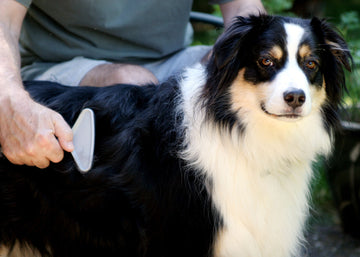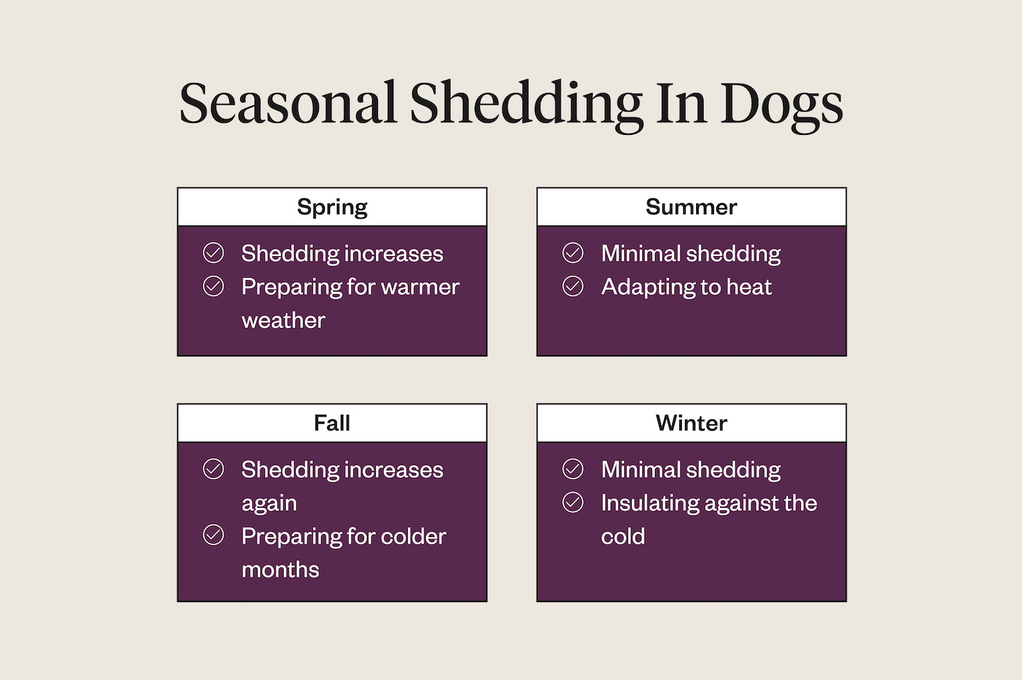8 Min Read
Do Dogs Shed In The Fall?
Key takeaway
Shedding is a normal and necessary process that lets dogs shed their old and damaged hair, making space for new growth. Fall shedding is especially significant as dogs gear up for the colder months.

Why pet owners are switching to online vet care with Dutch
-
Prescriptions delivered free to you
-
Fast access to Licensed Vets over video
-
Unlimited video visits and follow-ups
As the fall months arrive and the air gets crisper, you might start noticing something about your dog. Every time you give them a good petting, they seem to be shedding a lot more hair than usual. You might even come across clumps of dog hair just lying around on the floor.
So, to answer the question, "Do dogs shed in the fall?" – the answer is undoubtedly yes. In fact, dogs shed all year round for a variety of reasons. In this blog post, let's take a closer look at why dogs shed in general and why there's an uptick in shedding during the fall season. Follow along to learn more.
- Why Do Dogs Shed?
- Why Do Dogs Shed In The Fall?
- How To Manage Your Dog’s Fall Shedding
- Excessive Shedding And Hair Loss
- FAQs
- Final Notes
Why Do Dogs Shed?

Shedding in dogs is a natural and necessary process. It helps rid them of old and damaged hair to make way for new growth. This process is influenced by a variety of factors, including:
Hair Growth Cycle

Shedding is an innate part of the hair growth cycle. Without shedding, new hair cannot burgeon and grow. In the hair growth cycle of dogs, there are four distinct stages:
Genetics
Genetics significantly influence a dog's shedding. Different breeds have distinct coat types, varying from short to long, straight to curly, and single to double coats. These factors directly impact shedding frequency and amount. For example, double-coated dogs tend to shed more due to their insulating undercoat, while breeds with single coats usually shed less.3
Hormone Changes
Hormone changes can also impact shedding in dogs. As dogs go through the various stages of life, such as puberty, pregnancy, or aging, their hormonal balance undergoes shifts that directly affect their hair growth and shedding cycles.3
For instance, during puberty, increased levels of sex hormones can lead to thicker undercoats and heightened shedding. Similarly, pregnancy triggers hormonal fluctuations that might result in altered shedding frequency and volume. Aging dogs often experience changes in hormone production as well, which can lead to thinning coats and irregular shedding patterns
Health & Nutrition
Health and nutrition also play a pivotal role in a dog’s shedding.
- A well-balanced diet rich in essential nutrients, vitamins, and minerals supports healthy skin and coat development, leading to reduced shedding.
- Adequate protein intake supports the growth of strong hair follicles and minimizes excessive shedding.
- Poor nutrition can result in dry, brittle coats and increased shedding.
- Underlying health issues, such as allergies or hormonal imbalances, can also contribute to excessive shedding.3
Providing your dog with a complete and balanced diet is essential for the health of their skin and coat. Alongside this, regular veterinary check-ups can effectively address nutritional deficiencies and health issues, contributing to the maintenance of a healthy coat and minimizing shedding problems.
Why Do Dogs Shed In The Fall?

While shedding in the fall may seem counterintuitive, it actually helps dogs prepare for colder weather. Here's a breakdown of shedding across the seasons:
- Spring: As winter gives way to warmer temperatures, dogs shed their thick winter coats. This shedding process helps them adapt to rising heat, allowing for a lighter and more comfortable coat during the upcoming summer months.
- Summer: In summer months, shedding persists as dogs continue to rid themselves of their winter coat. This shedding serves to maintain a sleek and lighter coat, enabling better heat dissipation and overall comfort in hot weather.
- Fall: In the fall, the decrease in daylight hours and the onset of cooler temperatures trigger hormonal changes that prompt the growth of a thicker winter coat. Shedding during this time helps eliminate the old, lighter fur, making room for the new coat to provide insulation against the impending cold.
- Winter: Shedding slows down during winter, although dogs may still experience some light shedding. This shedding allows them to fine-tune their coat's insulation in response to fluctuating temperatures, ensuring they remain comfortable throughout the season.
As we’ve mentioned, shedding in dogs is a natural and necessary process. It enables dogs to regulate their body temperature and maintain optimal comfort as they navigate the ever-changing seasons.
How To Manage Your Dog’s Fall Shedding
At times, your dog’s fall shedding can seem out of control, but with the right strategies in place, you maintain a clean home environment while ensuring your dog remains happy and healthy.
Regular Grooming
Help your dog shed their lighter coat and prepare for the colder months with regular grooming. Here’s what you can do:
- Brushing: Brush your dog's coat with a deshedding brush on a regular basis. This helps prevent excess shedding by capturing and removing dead hair before it ends up on furniture and floors.
- Bathing: Give your pup occasional baths using a gentle shampoo formulated for dog shedding. Bathing your dog can help them loosen and remove dead hair, promoting a healthier coat and reducing shedding.
- Professional grooming: Consider scheduling professional grooming sessions, particularly for breeds with thicker coats. Professional groomers can use specialized tools and techniques to effectively manage shedding and help your pup maintain their coat health.
Active Tidying Around The House
If your dog tends to shed more heavily, it's crucial to establish a routine of tidying up around the house during shedding season. This practice becomes even more important if you have family members who are susceptible to allergies, as it can significantly enhance their comfort.
To start, make sure you regularly vacuum your home, paying special attention to the areas where your dog spends most of their time. This proactive step helps prevent loose fur from accumulating on carpets, upholstery, and floors. Additionally, consider washing your dog's bedding, blankets, and toys on a regular basis to minimize the spread of loose hair and maintain a clean living space. Lastly, keep lint rollers readily available to swiftly remove fur from clothing and upholstery.
Supplements
Supplements can support your dog’s skin and coat health. However, before giving your dog any supplement, you should always consult your vet first. They can give you advice that's tailored to your pup and suggest supplements that could work well for them.
Here are some vitamins and nutrients to look for in skin and coat supplements for dogs:
- Omega-3 fatty acids: These essential fatty acids, found in fish oil or flaxseed oil, can help reduce inflammation, improve skin moisture, and enhance coat luster.
- Biotin: Biotin is essential for healthy skin, hair, and nails.4
- Vitamin A: This vitamin supports cell growth and the maintenance of healthy skin and coat.
Excessive Shedding And Hair Loss
Excessive shedding and hair loss in dogs can be concerning for pet parents. While shedding is a normal part of a dog's hair growth cycle, an unusually high amount of shedding or noticeable hair loss might indicate underlying health issues.
Various factors can contribute to excessive shedding, such as poor nutrition, allergies, hormonal imbalances, skin infections, immune system disorders, liver disease, or parasites. In some cases, breed-specific characteristics can also play a role.1 Monitoring your dog's shedding patterns and paying attention to any changes in their coat can help identify potential problems early on.
If you notice significant hair loss, bald patches, or persistent itching, it's essential to consult your vet. A vet can conduct a thorough examination, run necessary tests, and recommend appropriate treatments to address any underlying causes, keeping your pup happy and healthy.
FAQs
What months do dogs shed the most?
Dogs tend to shed the most during spring and fall, with spring shedding helping them shed their winter coat and fall shedding making way for a thicker coat.
How often should I brush my dog to help with shedding?
Your frequency of brushing should vary based on your dog’s breed and coat type. For heavy shedders, daily brushing during shedding seasons is beneficial, while breeds that shed less may only require brushing a few times a week throughout the year.
Should I be worried about my dog’s shedding?
In most cases, shedding is a natural and healthy process for dogs to maintain their coat health. However, if you notice a sudden increase in shedding, bald patches, or signs of discomfort such as itching or skin irritation, it's advisable to consult a vet. Excessive shedding could be due to factors like allergies, hormonal imbalances, skin infections, or other underlying health issues. Regular monitoring of your dog's shedding patterns and overall coat condition can help you identify any unusual changes and seek appropriate medical attention if needed.

Final Notes
Shedding is a natural occurrence in dogs, particularly during the fall months. It gets rid of old or damaged hair and makes way for a coat that suits the season. Overall, shedding is crucial for dogs to effectively regulate their body temperature and maintain a vibrant and healthy coat.
Whether you have a preference for dogs that shed less or shaggy dog breeds, you can find more information on Dutch's blog. Our aim is to equip pet parents with all the necessary resources for their furry companions' happiness and well-being. With our online vet care, you can consult a licensed vet from the comfort of your home, have prescriptions conveniently delivered to your doorstep, and enjoy unlimited follow-ups for various pet concerns. Try Dutch today.Share
References
-
"Why does my pet shed?" American Animal Hospital Association. https://www.aaha.org/your-pet/pet-owner-education/ask-aaha/pets-and-shedding/.
-
Milner, Yoram. et al. "Exogen, Shedding Phase of the Hair Growth Cycle: Characterization of a Mouse Model." Journal of Investigative Dermatology. Sep. 2002, https://www.sciencedirect.com/science/article/pii/S0022202X15417737.
-
Moriello, Karen A. "Structure of the Skin in Dogs." Merck Veterinary Manual. Oct 2022, https://www.merckvetmanual.com/dog-owners/skin-disorders-of-dogs/structure-of-the-skin-in-dogs.
-
Frigg M, Schulze J, Völker L. Clinical study on the effect of biotin on skin conditions in dogs. Schweiz Arch Tierheilkd. 1989;131(10):621-5. PMID: 2602924.



